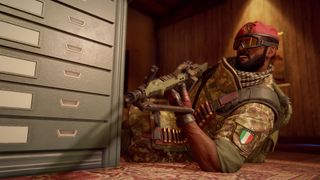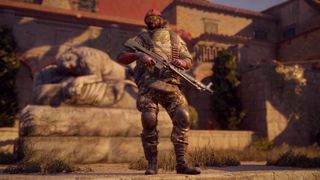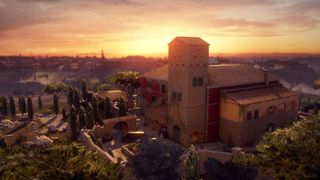Everything you need to know about Rainbow Six Siege: Operation Para Bellum
Lasers? Holograms? Bulletproof Cameras? Why not.

Rainbow Six Siege’s Operation Para Bellum has finally been revealed in full during the Pro League Finals, finally giving everyone a good look at two new defenders, a new map, and a target release date of June 5. After spending some time playing the new stuff over the weekend at Ubisoft's event, I think it’s going to be a fun season.
Alibi
Alibi is a 3-speed, 1-armor defender from the Italian Gruppo Intervento Speciale. Her unique gadget is the Prisma, small devices that she can throw to deploy a hologram decoy. Her three decoys look just like her, the only giveaway for attackers being that they stand still and appear slightly less detailed than Alibi. Walking through or shooting the decoy will temporarily reveal an attacker’s location to the defenders. This might sound similar to Lion’s map scan that highlights enemies with a bright red outline and reveals their identity, but it’s much more like getting tracked by Jackal. Your location is updated with a ping for only a few seconds, so it doesn’t feel like too much of a punishment.
That is, unless the real Alibi is lurking nearby to capitalize on your mistake. I found the most success with the decoys by placing them where enemies would likely be expecting me to hold a position—behind a piece of cover and at a tight angle looking at a doorway or window. As the enemy peeked a doorway to clear all the angles, the brief spotting of my decoy’s head was the perfect bait. The decoys do rematerialize after being shot, but there are plenty of ways to get rid of them permanently. The device itself forms a base at the bottom of the decoy that can be shot, blown up, smacked, or zapped by a shock drone. IQ can see it on her scanner and Thatcher can temporarily disable them.
It’s hard to tell this early just how effective the decoys will be. As none of us playing were used to seeing them, we were shooting them and getting spotted pretty often. That said, I also began to think twice when I saw one, especially when they were placed somewhere unlikely, like the middle of a room.
Alibi’s kit is built completely for her strengths as a roaming trickster. Presentation director Alex Karpazis went so far as to call her the “ultimate roamer.” She can take the Mx4 Storm submachine gun, ACS12 shotgun, Bailiff 410 revolver, and Keratos .357 revolver. The Bailiff is unique because, despite being a revolver, it fires shotgun shells. It also comes pre-equipped with the same red dot sight found on Zofia and Ela's pistols. It's a novelty gun, but plenty of fun in practice. I can foresee her most popular loadout being the Storm and Bailiff, as one is good for mid-range and the other for opening murder holes and hatches.

The other standout here is the ACS12, which is inspired by the AA-12 shotgun, which you might've seen in The Expendables or Killing Floor 2. It’s the first truly automatic shotgun in the game, and its destructive power is absolutely massive. It even outperforms Buck’s masterkey when it comes to breaching. If you’re already keen on shotguns, you’ll be big on this one. But, since Alibi’s only secondary options are another shotgun or a standard revolver, you lose lots of versatility if you take it as a primary.
Maestro
Maestro is billed by Ubi as an aggressive anchor, a departure from what we expect from 1-speed ops like Doc, Rook, and Echo. As opposed to their soft-hitting MP5’s, Maestro carries a giant LMG, the Alda 5.56 (based on the CTME Ameli machine gun used by the Italian military). His unique gadget, the Evil Eye, is a deployable camera unit that can fire high-energy laser beams. Don’t worry, it’s just as cool as it sounds.
PC Gamer Newsletter
Sign up to get the best content of the week, and great gaming deals, as picked by the editors.
He can deploy two of them and can only operate them through the observation tool. Similar to the new bulletproof camera gadget, the Evil Eyes are immune to gunfire, can see through smoke, and can tag enemies. Maestro can only fire the camera’s laser while the bulletproof shield is open, leaving it vulnerable to gunfire. The lasers have unlimited ammo, but need to cool down after continuous use. The laser will damage enemies, but at only five health per zap. Similar to the Yokai drone, a big strength of this thing seems to be its ability to delay objective capture.
When placed near a hostage or bombsite, attackers will need to deal with it. In a tense situation between two rooms, having an Evil Eye in a room with enemies could go a long way in harassing them and even killing them if they can’t take it down. And taking it down isn’t as easy as it sounds. When the user isn’t firing the laser, the camera is immune to all types of damage except for explosions and Sledge’s hammer.
And when the Evil Eyes do go down, Maestro is more than capable of taking on odds that aren’t in his favor. His Alda LMG is a powerhouse compared to the vast majority of defender weapons, bolstered by its ability to equip an ACOG. Like Alibi, he can also take the ACS12, Keratos, and Bailiff revolver. I had fun experimenting with the Evil Eye and the Bailiff by opening holes in a line to zap enemies through. It took them longer to realize where the lasers were coming from, leaving me plenty of time to close the shield on the camera.

The most creative use of the Evil Eye I saw was a teammate that deployed one not on the objective, but above it. When the enemy Thermite came in to breach the hatch, my teammate promptly zapped his charge out of existence. It’s like having Twitch’s shock drone on defense, and it’s pretty awesome.
Villa
Ubisoft is extremely confident in its new map, so much so that when it releases, the map is going straight into the Pro League pool. After a few hours with “the most competitive map to date,” I’m beginning to understand why. Villa’s biggest strength is that it goes back to the basics of what makes a great Siege map.

Nothing about Villa feels high-concept or audacious, and that’s a good thing.
The beautiful country house is a mashup of close quarters combat and long-range hallway brawls. Contrary to the seemingly all-cement makeup of Siege’s last new map Tower, Villa has a healthy variety of soft walls, floors and ceilings made up of wood and drywall. A stone basement sits subtly beneath the house storing barrels of wine, one of which will need to be breached to access it from the outside. A skylight sits near the middle of map that looks all the way down to the first floor.
Nothing about Villa feels high-concept or audacious, and that’s a good thing. It’s a simple, good map. The scenic courtyard and fountain that sit outside the house provide ample cover from spawn peeking. There are few windows that require rappelling to access, meaning that attackers will have a much easier time reaching the second floor without taking the stairs. Another nice balancing decision is that all objective sites have buffer rooms between the outside, meaning the strategy of planting the defuser at a window, hopping out, and watching it from outside will probably be impossible.

Wrap up
After the experimental Operation Chimera that introduced global abilities and a wild zombie alien mode, it feels appropriate that Para Bellum takes us to a quaint and soothing Italian countryside with operators that have a lot of creative potential. I had a lot of fun with both Maestro and Alibi, but Maestro seems especially harder to get a handle on. I have concerns about how durable his Evil Eyes are. If Maestro keeps the shield closed and uses it only as a camera, then explosives and a sledgehammer are the only ways to take it down. This might prove too powerful, but time will tell.
Alibi feels like a great addition to the family of roamers, and her emphasis on psychological warfare will make for some amazing plays. That said, players might build up an immune system to her tricks to the point where her decoys are rarely useful. Add in a simple and fun map, and Para Bellum might be one of the best seasons for Siege since launch.

Morgan has been writing for PC Gamer since 2018, first as a freelancer and currently as a staff writer. He has also appeared on Polygon, Kotaku, Fanbyte, and PCGamesN. Before freelancing, he spent most of high school and all of college writing at small gaming sites that didn't pay him. He's very happy to have a real job now. Morgan is a beat writer following the latest and greatest shooters and the communities that play them. He also writes general news, reviews, features, the occasional guide, and bad jokes in Slack. Twist his arm, and he'll even write about a boring strategy game. Please don't, though.
Most Popular

